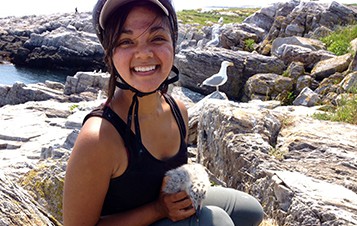 Photo ©
Sara Gonzalez
Photo ©
Sara Gonzalez
Life In A Gull Colony
by Taylor Heaton Crisologo, Cornell University, ’16
My first time in a gull colony was a riot of vocalizing birds and flashes of white wings. However, once the gulls settle, the finer details come into focus. By sound, the chorus of yeow calls and the occasional long call echoing through the colony. By sight, the great expanse of densely-packed nests dotting the nooks and crannies of the rocky terrain. By atmosphere, the sensation when a good breeze blows through and dozens of gulls lift off and hover lightly in the sky.
This scene was not always so lively. In 1900, only about 8,000 Herring Gull pairs were left in the United States due to feather collecting for ladies’ hats and egg collecting by hobbyists. Today, with federal protections in place for all native birds, there are at least 90,000 to 100,000 breeding pairs along the East Coast. The Herring Gulls that I study nest on Appledore Island, a small island off the coast of Maine and New Hampshire. There, the colonies offer opportunities for students at the island’s field station, Shoals Marine Lab, to gain experience in field research through summer-long monitoring projects.
Typical Herring Gull nest monitoring is similar to the work enjoyed by other NestWatchers, with some added twists. Information is meticulously collected on nest context, nesting density (the distances between the nearest neighboring nests), and egg sizes. Herring Gull eggs average about 90 grams, or about 50 times the size of a Tree Swallow egg! Once the nesting profile is completed, each nest is monitored from incubation to fledging.
This summer, with the guidance of Dr. David Bonter of the Cornell Lab of Ornithology, I investigated the connections among nesting success, shelter availability, and nest defense behavior. To test the importance of nest shelter on reproductive success, I placed artificial chick shelters at sites with little natural cover from predators and the elements. By linking the results of my experiments to the nest success data, I hope to gain further insight into the factors which may be limiting the survival of chicks in this system.
While I’m still analyzing my field data from the summer, one thing is certain: this breeding colony of Herring Gulls provided my first experience in ecology. My weeks spent nest monitoring and collecting data have offered me insight on staying positive, thinking critically and creatively, and rolling with the dive-bombing birds (note the bicycle helmet in the photo). I’m so grateful to the gulls for providing me with these data to ponder and for helping me start my career as an ornithologist. So thank you, gulls, for being the first birds to take me under your wings.
Interested in watching gull nests? Here are Taylor’s tips for successful gull nest monitoring:
- Be respectful to the gulls when you’re in the colony. Always remind yourself that their intense responses are just examples of how awesome they are at defending their nests and young!
- Move quickly to avoid prolonged disturbance, but be sure to collect careful and precise data.
- Carry an object that extends beyond your height, like a stick held high overhead. Gulls will always aim for the highest point, so this method is great for directing surprise dive-bombs to something other than your head!
- In case you do encounter a dive-bomb, be prepared by always wearing a bicycle helmet.
- If you can, find a safe distance to perch and watch the colony activities. The gulls have a wide range of fascinating behaviors to observe and appreciate, so grab your binoculars and go!
 Photo ©
Photo ©